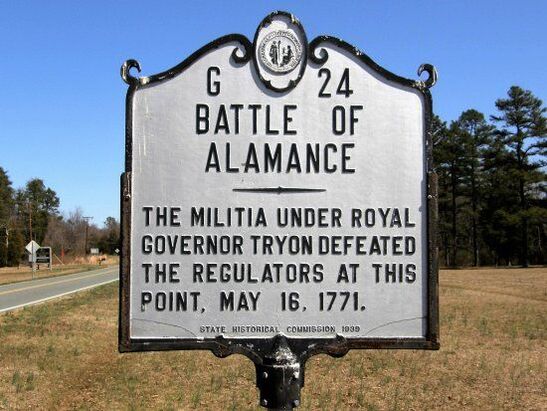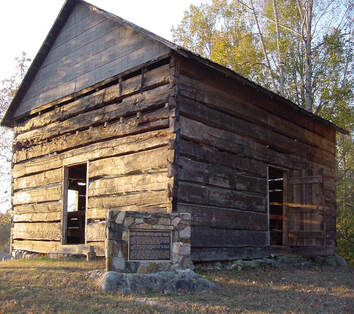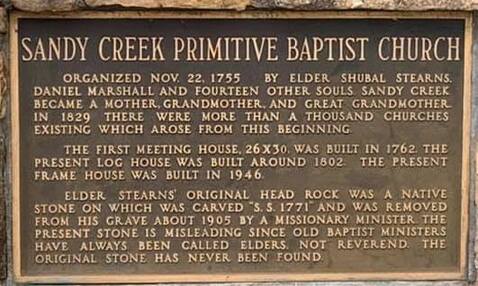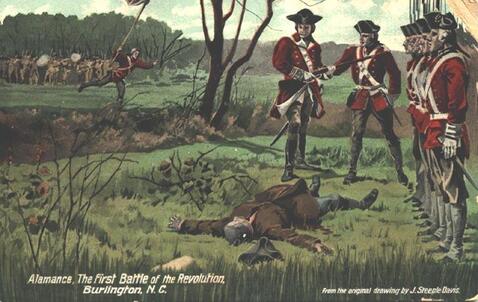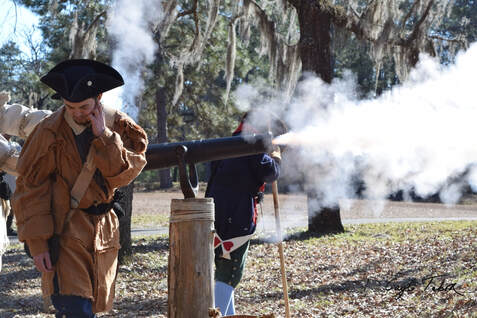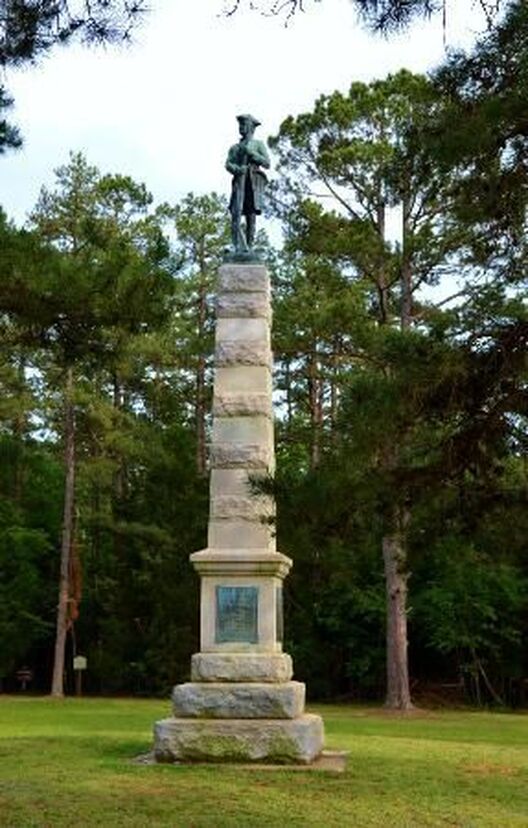Battle of Alamance
Text form a presentation by Gerald "Jerry" B. Breed on 16 May 2020 at a
Zoom meeting of the Piedmont Chapter Sons of the American Revolution.
Zoom meeting of the Piedmont Chapter Sons of the American Revolution.
You know about the Boston Massacre which occurred March 5, 1770 and the battle at Lexington and Concord which occurred April 19, 1775. This paper is about an important event which took place in North Carolina in 1771.
South of Burlington, North Carolina on highway 62 you will see a historical marker which notes The Battle of Alamance where “the militia under Royal Governor Tryon defeated the Regulators May 16, 1771”. This historic event ended what at the time was known as the frontier Regulators War or Regulators movement. I became interested in this battle as I was researching my family history and learned that my family lived in the area during the time of the Regulator Movement.
These citizens were known as Regulators because they wanted to regulate their own affairs and they wanted to "regulate" a corrupt government. Basically, they were: farmers and frontiersmen who wanted an open, honest and fair government.
There was a community near Alamance called Sandy Creek and in 1764 farmers in the community formed the Sandy Creek Association to protest against corrupt government officials, unfair taxes and fees, and other practices of the Royal Government. The association officially disbanded in 1766 but members continued their protests and became known as Regulators.
Orange County Sheriff Hawkins and Court Official Col. Edmund Fanning, were appointed by the governor and they were two of the corrupt officials. Fanning was a Yale graduate from NJ. He was an attorney and considered himself the most intelligent man in the county. The citizens staged protests and sent a petition to Gov. Tryon listing their grievances: On April 8, 1768, Sheriff Hawkins seized a farmer’s horse because the farmer could not pay his taxes. Eighty angry Regulators marched on the county seat at Hillsborough. Armed with "clubs, staves & and cloven muskets," the group captured and bound Sheriff Hawkins, then "rescued" the horse and tack. As they left town, some of the group fired shots into the roof of Colonel Fanning's house. Fanning was away at the time, attending court in Halifax. Informed of the Regulators' actions, he ordered the arrest of three "ringleaders" of the riot, then called out seven companies of the Orange militia. Next, he hurried back to Hillsborough to take command of the militia forces, writing Governor Tryon an agitated letter asking for more authority to deal with the "traitorous Dogs . . ." On hearing the news, Tryon's Council declared the Regulators guilty of insurrection. Regulators Herman Husband and William Butler were arrested by Fanning and charged with "inciting to rebellion." After 700 Regulators marched on Hillsborough, the prisoners were released on bail but tensions continued to mount.
As background let’s talk about the situation in the Carolinas 1765-1771.
The Provinces of North Carolina and South Carolina experienced dramatic population growth in the 1760s. There were several contributing factors: The French Indian War, migration from more developed Provinces and immigration. Land was offered as incentive to immigrants from Great Britain.
Of the thirteen colonies North Carolina was the fourth most populous. Approximately 30% of the population were from Germany. English, Scots, Scots-Irish, French, Swiss and African made up the remainder. The backcountry was predominantly Scot Irish and German. The coastal counties were mostly English and African. The Carolinas were carved out of VA and the Lord Proprietors wanted an Aristocracy ruling over uneducated peasants and slaves with the Church of England as the established Church. All others were considered Dissenters. Everyone had to pay a poll tax for the upkeep of the Anglican Parish Church and Minister.
The Provincial Capitol was located in New Bern on the coast and William Tryon was the Royal Governor. He was an advocate for the Established Church of England. He was a trained British Army Colonel and was commander in chief of the militia.
People in the backcountry were poor, not well educated and not well represented in the North Carolina government. There was a 10 to 1 underrepresentation, of the frontier counties in the legislature at New Bern.
Gen. Edward Braddock’s defeat by the French and Indians near Fort Duquesne, (Pittsburg) July 13, 1755 left the frontier of PA, VA, MD unprotected and many families moved south. Geo. Washington was a 22 years old aide- de- camp to Braddock. The population in backcountry North Carolina grew from a few hundred in the 1740s to more than 40,000 by 1767. There was a basic road system connecting Philadelphia to the Southern Provinces. Many of these wagon roads were former Indian Trails.
The religious movement known as the Great Awakening in America occurred 1740-1750 and the frontier was fertile ground for evangelist. Some scholars have looked at the role that evangelical Christianity may have played in shaping the social and political views of the Regulator rebellion. The religion of Herman Husband and other Regulators was Protestant. They were members of Baptist, Presbyterian, Quaker, Moravian, and other sects which emphasized autonomy, an individualistic approach to church, salvation, and morality that may have influenced their views of equality and economic issues. They desired to have freedom of religion. It has been argued, this brand of Christian faith bonded the Regulators and contributed to their antiauthoritarian stance toward what they believed to be an unjust governmental structure.
Joseph Breed and his family were members of Sandy Creek Baptist Church established in 1755 by Shubal Stearns, Daniel Marshall, Joseph Breed, Priscilla Avery Breed and families. These families came from New England. They were Christian Evangelist and much of their preaching was done outside. They were called Separate Baptist because they wanted to separate from other more orthodox religions such as the Church of England. Their first building was constructed in 1762. By 1772, forty-two churches traced their lineage to the Sandy Creek Church.
Their involvement was recorded by church historian Morgan Edwards in his "Materials towards the History of the Baptists in the Provinces of Maryland, Virginia, North Carolina, South Carolina, and Georgia," written 1772-1776. He was also the founder of Brown University.
The coastal cities were more developed and Royal Governor William Tryon had a lavish home built in 1770 in New Bern. The governor’s residence was called Tryon’s Palace and taxes were needed to pay for it. This was resented by the Regulators, who were already paying substantial taxes. The Regulator William Butler was quoted as saying, "We are determined not to pay the Tax for the next three years, for the Edifice or Governor's House, nor will we pay for it."
Battle lines are formed at Alamance on May 16, 1771
A stalemate occurs between the Regulators and the government and the stage is set for a major confrontation. The Regulators take up arms and meet in that field at Alamance. The Regulators call for redress of their issues with the Governor. Tryon refuses to negotiate and calls up the Militia primarily from the coastal counties and heads to Alamance.
Arriving at Alamance, Tryon sent an officer to say that unless they disbanded promptly he would fire on them. Tryon shot Robert Thompson, the white flag bearing emissary from the Regulators. "Fire and be damned" was the Regulators answer, and orders were issued to fire. After the first canon blast was fired most of the Regulators fled, leaving only 300 hundred to fight. The Regulator “leader” Herman Husband had departed the field citing his Quaker faith.
The Regulators were poorly organized, lacked military training, untested leadership. Many came to protest not to fire on the militia. Only half had weapons. Gov. Tryon was a Colonel in the British Army and the Provincial Militia was better trained and equipped. Some did not want to fire on their fellow countrymen. Tryon said “fire on them or fire on me.” They began firing.
The Regulators had more men on the field (about 2000) but Tryon’s forces were equipped with 6 canons, a company of Rangers, Light Infantry and 130 trained officers and 1,500 men. There are differing accounts of the number of killed and wounded. As many as 25 Regulators were killed and many more wounded. At least 9 of Tryon’s Militia were killed and 60 wounded.
The Aftermath -Tryon won the battle and subsequently set up camp at Sandy Creek which was the home of Herman Husband and many other regulators. His militia took approximately 15 prisoners, one (James Few the brother of William Few) was hanged without even the show of a military court. The prisoners were shackled and paraded through the community.
Tryon’s militia traveled throughout the Regulator territory where he burned homes, took livestock and destroyed crops. All Regulators were required to sign Oaths of Allegiance to the Crown or face the gallows. Tryon issued a Proclamation: “I do therefore give notice that every Person who will come in, either mine or General Waddells Camp, lay down the Arms, take the Oath of Allegiance, and promise to pay all Taxes that are now due or may hereafter become due by them respectively, and submit to the Laws of this Country, shall have His Majestys most gracious and free pardon for all Treasons Insurrections and Rebellions.”
He also raised taxes to pay for his militia's defeat of the Regulators. Many Regulators moved across the mountains into the area which would become Tennessee, establishing both the Watauga Association in 1772 and the State of Franklin in 1784. Other families fled to Virginia, South Carolina and Georgia.
Several of the Sandy Creek refugees went to the junction of the Watauga and Holston Rivers near Gray, Tennessee and established Buffalo Ridge Baptist Church, the first church in Tennessee. Its first pastor was Regulator Tidence Lane. He and six of his sons served as Patriots. Many relatives and descendants of these refugees from Sandy Creek became "Overmountain Men" who came, 1,040 strong, over the Blue Ridge Mountains to lead the effort which whipped Patrick Ferguson and the Tories at the Battle of Kings Mountain in 1780, just 9 years after Alamance.
A trial was held at Hillsborough and 12 of the Regulators were found guilty of treason and sentenced to death. Six of the twelve Regulators were hanged at Hillsborough, N.C. on June 19, 1771: Captain Messer, James Pugh, Robert Matear, Benjamin Merrill and 2 Unknown. Six were pardoned.
While Tryon won the battle, one could argue that seeds of future rebellion were firmly planted in the minds of the men and families who were defeated and forced to flee the area. James Pugh, was said to have stated “Our blood will be as good seed in good ground that will soon produce one hundred fold.”
Epilogue
Following the Battle at Alamance.
Gov. Tryon went to New York as Gov. and was subsequently promoted to Major General. As a General leading British forces in New York and CT he was ruthless. His tactics were to burn and pillage, waging war against civilians.
Fanning followed Tryon to New York as his personal secretary. At the start of the American Revolutionary War, Patriots drove Fanning from his home, forcing him to seek refuge aboard HMS Asia in the New York harbor. After being commissioned a colonel by General William Howe, Fanning raised a regiment of Loyalists named the King's American Regiment on Staten Island, New York. After the war, Fanning was appointed lieutenant governor of Nova Scotia, and helped oversee the resettlement of other Loyalist refugees in the province.
Regulator Richard Caswell became the first American Governor of North Carolina.
Regulator Elijah Clarke became a militia leader in Georgia. We know about his leadership at the battle of Augusta, Kettle Creek, Blackstock Plantation and Musgrove's Mill.
Regulator William Few became a Georgia Militia leader, First Senator from Georgia and signer of the U.S. Constitution
Regulator Herman Husband fled to PA and in 1791 became one of the organizers of the Whiskey Rebellion which opposed the taxes on alcohol.
Following the Battle at Alamance, Sandy Creek Baptist Church membership dropped from 606 to only 14 members. The Breed family moved to South Carolina and helped organize the Fairforest Baptist Church. This was the first Baptist Church in upstate SC.
Rev. Joseph Breed’s sons Joseph Breed Jr, and Nathan Breed, his sons in law Richard George and Obediah Howard were all members of Col. Thomas Brandon's Fairforest Patriot militia in South Carolina. Brandon's Regiment served in Revolutionary War Battles at: Ramsours' Mill, Stallions Plantation, Musgrove's Mill, Battle of Kings Mountain, and the Battle at Cowpens. Priscilla Avery Breed is also a Patriot having provided beef for the S.C. Militia.
In 1776, a Declaration of Human Rights was appended to the state constitution of North Carolina. Article II was written to insure that, the People of North Carolina have the sole and exclusive rights to regulate the internal affairs of Government. In 1880 a handsome monument was placed at the Alamance Battlefield and the North Carolina SAR and DAR recognize this event annually.
HERE WAS FOUGHT THE BATTLE OF ALAMANCE MAY 16TH, 1771 BETWEEN THE BRITISH AND THE REGULATORS
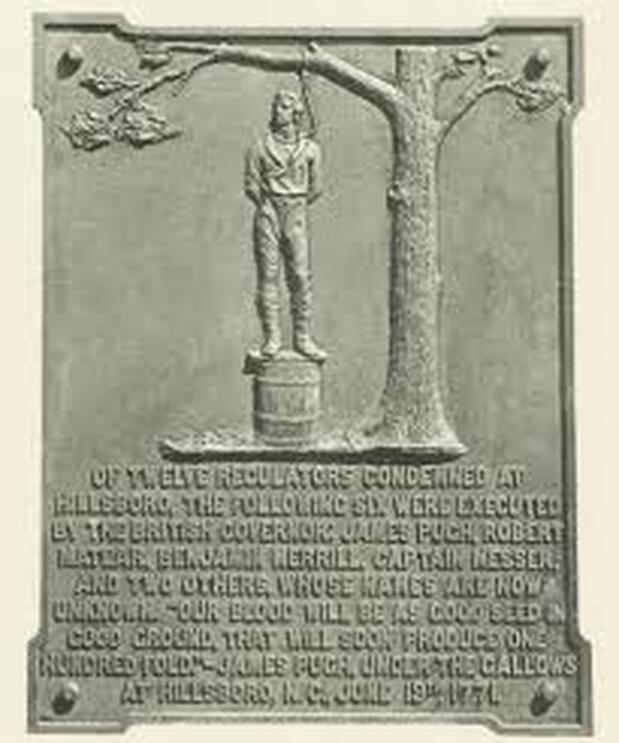
Plaque from battleground monument. Reads: "Of the twelve regulators condemned at Hillsboro, the following six were executed by the British Governor: James Pugh, Robert Matear, Benjamin Merrill, Captain Messer, and two others whose names are now unknown. "Our blood will be as good seed in good ground, that will soon produce one hundred fold." - James Pugh, under the gallows at Hillsboro, N.C., June 19th, 1771."
Resources
Morgan Edwards, "Materials towards the History of the Baptists in the Provinces of Maryland Virginia, North Carolina, South Carolina, and Georgia," Philedelphia 1776
David Benedict, A General History of the Baptist Denomination in America and Other Parts of the World (Boston: Lincoln & Edmands, 1813; reprint, Gallatin, TN: Church History Research & Archives, 1985)
Robert Baylor Semple, A History of the Rise and Progress of the Baptists in Virginia revised and extended by G. W. Beale (originally published 1810, rev edition in 1894; reprint, Lafayette, Tenn.: Church History Research and Archives, 1976)
Marjoleine Kars. 2002. Breaking loose together the Regulator Rebellion in pre-revolutionary North Carolina. Chapel Hill: University of North Carolina Press.
William Stevens Powell. 1989. North Carolina through four centuries. Chapel Hill: University of North Carolina Press.
William Stevens Powell, James K. Huhta, and Thomas J. Farnham. 1971. The Regulators in North Carolina: a documentary history, 1759-1776. Raleigh [N.C.]: State Dept. of Archives and History.
James Donovan Mosteller, A History of the Kiokee Baptist Church in Georgia (Ann Arbor, MI: Edwards Brothers, Inc., 1952)
Elder John Sparks The Roots of Appalachian Christianity: The Life and Legacy of Elder Shubal Stearns, University Press of Kentucky March 25, 2005

